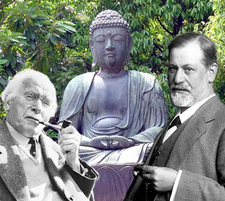by Evelyn Cash
For the past two months, I’ve started my day in much thesame way nearly every day. I wake up,wash up, then step into the spare bedroom in our apartment. The room is primarily an office, full ofbooks, important documents, a desk and so on but we also keep a small altar onthe top of one of the waist-high bookshelves. I step into the room, in the dark of the pre-dawn morning, light acandle, make a bow and then begin my morning yoga practice. I take that morning practice easy, just basicposes chosen to wake up my body, stretch my muscles and loosen my joints aftersleeping and allow me to re-connect with my breath. After I’ve completed the yoga, I sit forzazen on a zafu facing a part of the wall that is not covered by a bookshelf ora desk. Once my meditation is complete,I set an intention for the day, chant the three refuges then I put out thecandle, make a bow and step out of my little make shift zendo and into myday.

I did not place much importance on regular ritual untilrecently. I’d attend zazen with thesangha when I could and when I couldn’t, I would sit at home without muchprep or ceremony. I’d just pull out the cushion, find a wall and sit facingit with a timer of some sort nearby. I’dmake a bow before starting zazen and a bow before getting up but little more. Something changed for me when I went on theRohatsu retreat right after Thanksgiving. At the
Growing up, I was one of the Protestant (Christian Methodist Episcopal in my case) girls at Catholicschool. We were the ones who remainedseated during the once a month mandatory school mass as most of the studentsand teachers rose for communion. As an outsider, I never really felt a deepconnection to the elaborate ceremony of the Catholic Church. I appreciated their ritualized mass andprayers but, by comparison, my own church had very little ritual. Sure, we had communion and a regular order toservice but our rituals had nowhere near the depth of complexity and intricacyof those that I saw during Catholic Mass.
Since becoming Buddhist, I have primarily practiced in smallgroup settings where much of the ritual has been reduced or abbreviated. It makes sense, when you only have a fewpeople, things naturally become simplified. When I went to the Zen Center for my weeklong retreat, I was able tocatch a small glimpse of what full Soto Zen service looks like. In some ways, I was reminded of the Catholicmasses I’d grown up attending but the purpose behind the rituals wasdifferent. In Zen, every ritual Ilearned about was meant as a practice of mindfulness. Each motion, each bow and each strike of adrum or gong helps to cultivate mindfulness of the present moment. The individual actions and motivations behindthe rituals are different but the result is much the same. Ritual helps us to gain a sense ofconnectedness to our practice – whether Buddhist or Christian – and to those whohave done the same ritual and practice for generations.
Over the break, I began reading Pema Chodron‘s “The Wisdomof No Escape.” She talks about the powerof ritual in Chapter 14: Not PreferringSamsara or Nirvana. She says,”ritual is about joining vision and practicality, heaven and earth, samsara andnirvana,” she goes on to write: “ritual, when it’s heartfelt, is like a timecapsule. It’s as if thousands of yearsago somebody had a clear, unobstructed view of magic, power, and sacredness,and realized that if he went out each morning and greeted the sun in a verystylized way, perhaps by doing a special chant and making offerings and perhapsby bowing, that it connected him to that richness. Therefore he taught his children to do that,and the children taught their children, and so on.”
A ritual can be just about any set of actions that helps bring that sense of connectedness to something greater; or asChodron put it, anything that joins “vision and practicality,” in a meaningfulway. I’ve come to see, first-hand, howrituals can have their own personal meaning for each individual. My morning ritual of lighting a candle,practicing yoga, sitting zazen, chanting the refuges then putting out thecandle holds unique meaning for me. Making an incense offering or bowing to the rising sun may hold specialmeaning to someone else.
Do you have a ritual forstarting or ending your practice? Or, doyou mark the beginning and end of each day in a certain way
